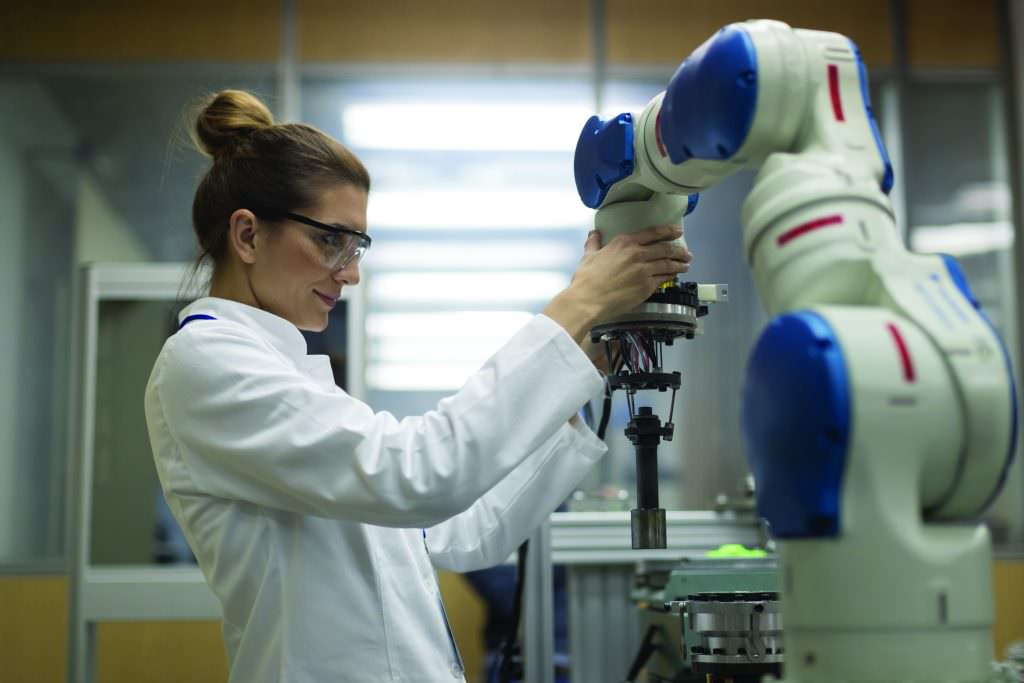Combining Man and Machine

Robots can help human guards to be more effective

Steve Reinharz, Robotic Assistance Devices
It may seem like science fiction to envision a world in which robotic devices are commonplace, but it is more realistic than one might think. Robots that leverage artificial intelligence (AI) are already in use in a wide variety of markets and applications. In manufacturing, robots are used to increase productivity and streamline the production process. They are also used to reduce the need for human personnel in mundane and repetitive roles. This allows companies to shift people to more valuable and higher-paying positions, such as those found in customer service, marketing, operations, and management, to increase morale and enhance operations.
For example, Seattle-Tacoma International Airport recently began testing a new use case for robots that provide tips to travelers on getting through security more quickly. The robot, stationed near screening areas, directs passengers to remove their jackets, take off their shoes, remove laptops from bags, etc. This tedious job that TSA agents would otherwise be performing can now be outsourced to a robot, freeing up airport employees to address more complex matters that can enhance security and efficiency.
Using Robotics in Security
The Sea-Tac example is just one of many that demonstrates how today’s advanced robotic solutions are being used.
Within the security market, robots are emerging as a way for businesses to augment existing security patrols and provide greater situational awareness.

And we have only begun to scratch the surface of what robotics can do to improve day-to-day operations.
Security robots can bring substantial benefits to businesses. They can patrol the perimeter of corporate campuses or critical infrastructure sites to identify potential trouble spots; remove traditional guards from dangerous situations; detect individuals or vehicles in unauthorized areas; and integrate with existing sensors and systems to allow operators to gain new levels of intelligence and insight into situations.
How does it work? Information gathered through sensors on the robot, such as video surveillance cameras, navigation equipment, motion detection, microphones and facial recognition software, is transmitted to a security operations center. The information is then analyzed and combined to create a complete picture of a situation that security personnel can use to make an informed decision on the most appropriate course of action.
Where Robots Are Used
Security robots can meet needs in many markets, but they are most valuable in large facilities, such as utility companies, oil and gas production sites, and education and corporate campuses. Robots deployed at these kinds of locales can patrol dangerous or hard-to-reach spots and provide surveillance of large areas more efficiently than human guards.
In these cases, robots serve as an extension of existing security operations and a manned guarding contingent. Expansive areas where numerous guards would need to be present to offer full coverage can be served well by robots that offer additional “feet on the ground.”

Robotics and AI
As mentioned above, security robots use multiple sensors and bring the information together. Open-platform applications work together seamlessly to collect and analyze data. AI software is embedded to provide security officials with the ability to analyze the images captured by onboard cameras. The information gathered through this and other sensors on the robot is critical to the implementation of a comprehensive strategy and tactical response.
Additionally, through the use of advanced AI technologies, robots can “learn” their surroundings. They are initially programmed to navigate a particular route, but as they continue on this path numerous times, the robot can make adjustments. AI makes this possible by giving the robot the “brains” to engage with its surroundings. This approach has the potential to add significant value to patrols.
AI also makes it possible to recognize patterns within large amounts of collected data. In the case of robotics, this can include automatically searching through video surveillance feeds for anomalies. Security-based AI, however, is narrower in focus, executing certain defined tasks such as object recognition or navigation.
Advanced object recognition is what enables a robot to become a core part of the enterprise security team.
Leveraging this type of AI allows robots to identify when a human or vehicle is approaching a perimeter and then execute a set of procedures in line with an organization’s goals.
Guards and Robots: A Natural Fit
Innovations in robotics and AI have some security professionals fearful that robots will one day “take over” human responsibilities. That is not the case. In fact, robots and people work best when they work together. With the robot revolution upon us, guarding companies see the value of these solutions and aim to take advantage of their capabilities. There are more than 1 million security guards employed in the United States, according to the U.S. Department of Labor’s Bureau of Labor Statistics, and that number is growing.
The partnership between human and robotic guards creates numerous advantages, including advanced patrolling capabilities and added responsiveness.

Robotics providers are finding ways to seamlessly integrate their technology with guarding companies by offering additional ways to collect information and send it back to an organization’s security operations center.
Some of the largest guarding companies in the United States recognize the value of robotics in decreasing the number of “dangerous” roles assigned to people, reducing liability and potential accidents.
For example, it would be costly, and perhaps unreasonable, to post a person at a utility site that is hundreds of miles away from a corporate facility. However, a robotic guard would be a perfect fit. There are also some toxic waste dumps where protection is needed, but a human presence is best avoided.
Robots can also be useful in more mundane jobs, such as working a late-night shift performing perimeter checks several times each hour. Redistributing such monotonous work frees human security guards to take on more strategic tasks, and saves employers health care, labor and insurance costs.
Best Practices for Implementation
For many enterprise organizations, security robots are an emerging concept and a new addition to a comprehensive security strategy. Therefore, certain considerations must be taken into account before the implementation of the technology – especially when human guarding is used, as well. Here are some tips for implementing security robots into an organization:
n Know the technology uses – Before any robots deploy, an organization must decide what it wants to get out of the investment. Will robots be used strictly for perimeter security? Just for remote locations? Only during large-scale events? These decisions should be made before any change in strategy is implemented.

- Educate the team – Robotics, in general, can have a negative connotation, leading human guards and other security team members to wonder, “Am I being replaced?” The best way to handle this concern is to maintain constant communication about the changes being made. This can be accomplished through seminars, announcements in team meetings, or training sessions that outline exactly how the robots will be used and why.
- Provide training – Security robot manufacturers are in the business of ensuring that their technology is used as efficiently and effectively as possible, which means training is crucial to the deployment process. Identify anyone who will be working with the robots and give them the opportunity to take courses on how best to use the technology.

- Develop standard operating procedures for robot use – Introducing robotics makes it mission-critical to provide new SOPs. If a security operations center is in use, these procedures must also be put into the database so that security guards who are monitoring the robot’s patrol can go through the proper steps in the event of an incident.
Robotics can provide significant value in various applications. It is critical for enterprise organizations to weigh the costs and benefits of implementing this new and innovative technology to meet today’s and tomorrow’s business needs. As security robots continue to produce strong improvements to customers’ programs, they will become as ubiquitous as their human guarding partners.
Steve Reinharz (steve.reinharz@roboticassistancedevices.com) is president of Robotic Assistance Devices (www.roboticassistancedevices.com).
